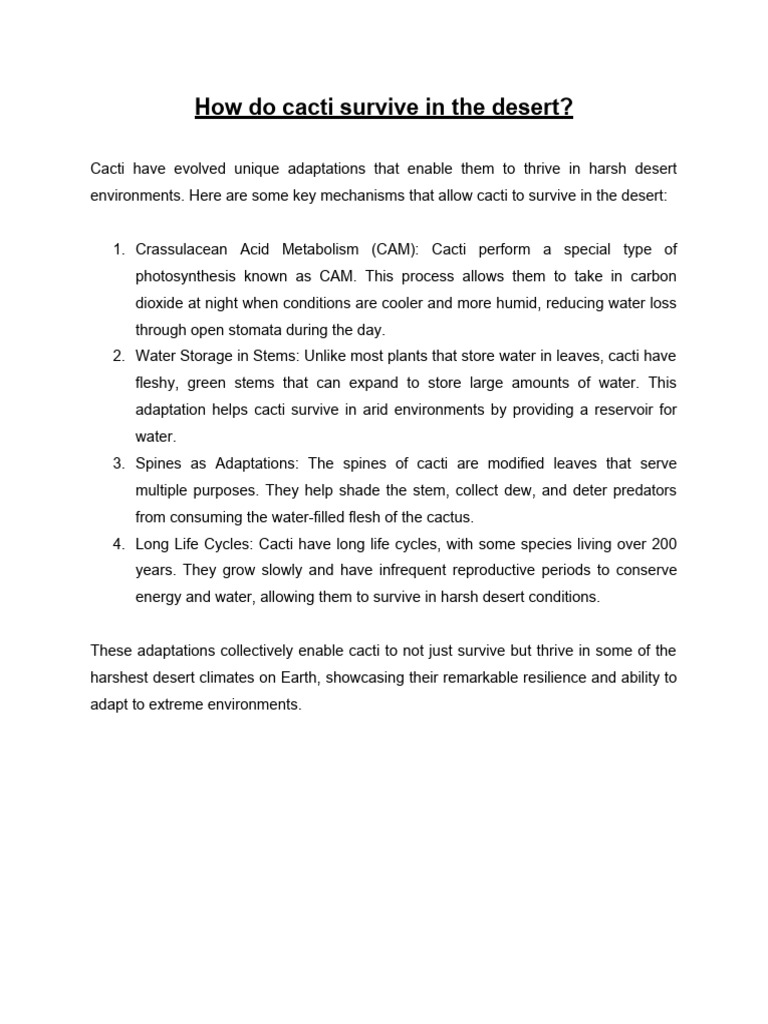The intriguing world of cacti is filled with adaptations that allow these remarkable plants to thrive in environments that many would deem inhospitable. Understanding how cacti acquire energy provides a fascinating insight into their survival mechanisms. Cacti have evolved various strategies to convert sunlight into energy, effectively utilizing their unique physiology to meet the demands of extreme aridity. This exploration will unveil the sophisticated processes that enable cacti to flourish in the arid deserts, transforming our perspective on how life can endure in seemingly barren landscapes.
Photosynthesis: The Power of Sunlight
At the heart of energy acquisition in cacti lies a process known as photosynthesis. Cacti, like all green plants, possess chlorophyll, the pigment responsible for capturing sunlight. While many plants utilize a mechanism called C3 photosynthesis, cacti have adapted to employ a more efficient process known as Crassulacean Acid Metabolism (CAM). This innovative pathway allows them to open their stomata at night instead of during the scorching daytime. By doing so, they minimize water loss, capturing carbon dioxide when temperatures are cooler and humidity levels are higher.
During the night, cacti convert CO2 into malic acid, which is stored in vacuoles within their cells. When daylight arrives, the stomata close to protect the plant from excessive water evaporation. The malic acid is then converted back into CO2, which is used in the Calvin cycle to produce glucose. This ingenious adaptation not only conserves water but also allows cacti to maintain their energy levels despite the harsh conditions they endure. It is a prime example of nature’s ability to innovate and thrive.
Water Storage: The Lifeblood of Photosynthesis
The effective use of sunlight for energy production is inextricably linked with water management. Cacti possess an extraordinary ability to store vast quantities of water, which is crucial for sustaining their energy production during prolonged dry spells. Their specialized anatomy, including thick, fleshy stems that act as reservoirs, enables them to absorb and retain significant amounts of moisture when it is available.
This remarkable water-storage capability is complemented by the waxy cuticle that coats their surfaces, significantly reducing transpiration. Some species also have evolved specialized structures known as “areoles,” which are modified branches that bear spines and flowers. These structures provide shade and further decrease water loss while also serving as a defense mechanism against herbivores, allowing the cactus to safeguard its vital water reserves.
Roots and Nutrient Acquisition: A Hidden Network
While above-ground adaptations are essential, it is the subterranean realm where cacti extend their quest for survival. The root systems of cacti are often extensive and branched, enabling them to absorb moisture quickly from any rain that might bless their environment. Some species even have shallow root systems designed to capture the elusive rainfall before it evaporates or seeps into the soil.
The interplay between roots and the surrounding soil is not merely about water absorption; it also encompasses nutrient uptake. Cacti thrive in nutrient-poor environments, but they employ unique strategies to siphon essential minerals such as nitrogen, phosphorus, and potassium from the soil. Mycorrhizal fungi often form symbiotic relationships with cactus roots, enhancing nutrient uptake and providing a further advantage in harsh habitats.
Photosynthesis and Respiration: The Energy Cycle
To fully appreciate how cacti utilize energy, one must understand the intricate dance between photosynthesis and respiration. While photosynthesis is the process through which cacti harness sunlight to create glucose, respiration is equally crucial as it breaks down that glucose to release energy for cellular activities. Cacti engage in respiration both day and night, albeit less efficiently during the hot daytime hours due to the closed stomata and reduced gas exchange.
During respiration, oxygen is consumed, and carbon dioxide is released—opposite to the photosynthesis process. The energy derived from the breakdown of glucose fuels vital functions, including growth, reproduction, and the maintenance of cellular structures. This duality emphasizes the remarkable effectiveness of cacti in energy utilization, sustaining life in an environment where resources are scarce.
Environmental Adaptations: Embracing the Harsh
Cacti are not just survivors; they are masters of adaptation. The numerous species exhibit a variety of morphologies and physiological traits that cater to their specific habitats. Some cacti have evolved to produce flowers that are pollinated during the cooler hours of night, further capitalizing on the unique rhythms of their environment while conserving critical resources.
Moreover, the pigmentation of cacti often varies as a response to sunlight intensity. The production of protective pigments can prevent sunburn, allowing these plants to bask in the harsh light without suffering damage. These adaptive strategies exemplify the resilience of cacti, highlighting their unique ability to manipulate their biology in response to environmental challenges.
Conclusion: A Testament to Resilience
To comprehend how cacti derive energy provides not only an understanding of their survival tactics but also a broader appreciation of life in extreme environments. The intricate dance of photosynthesis, water management, and nutrient acquisition represents a symbiotic relationship between these remarkable plants and their surroundings. As we deepen our understanding of cacti, we begin to understand the delicate balance of ecosystems and the resilience of life itself. The next time one gazes at a cactus standing stoically against the expansive desert, it is an invitation to reflect on the extraordinary adaptations that enable it to thrive against all odds.





Leave a Comment